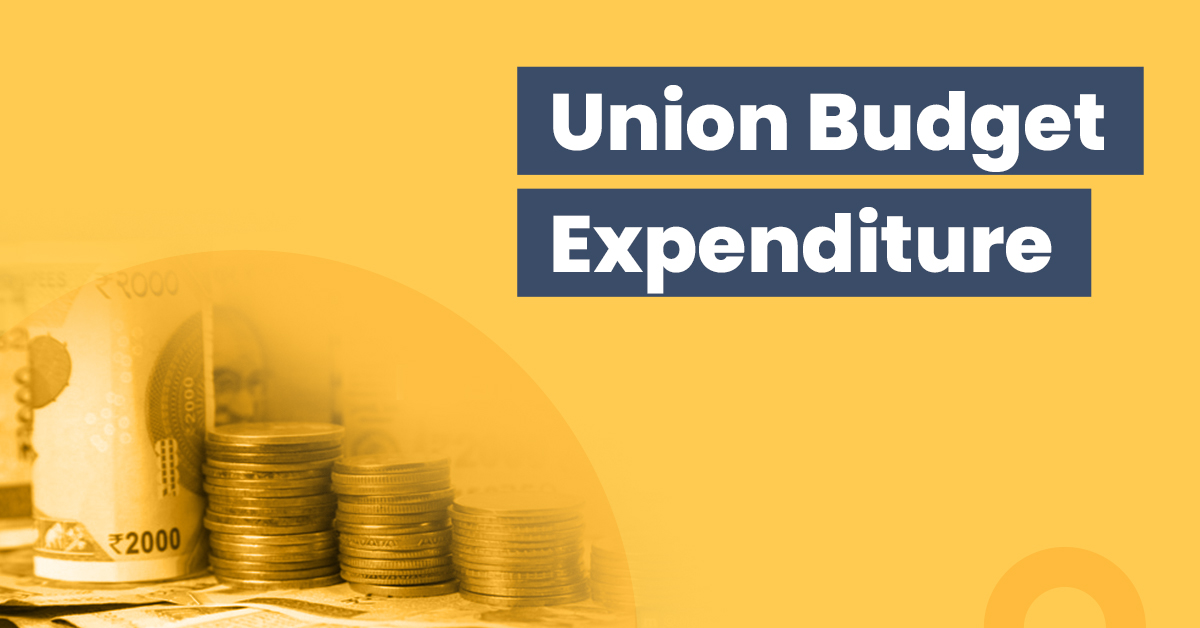Union Budget 2022-23 Expenditure: Highlights & Allocations


Union Budget expenditure is a financial statement of Government of India of allotment of funds for disbursement to various ministries, departments and sectors for the upcoming financial year. The expenditure of the budget is further segmented into capital and revenue expenditure.
Capital expenditures are allotted for creation of assets and are non-recurring in nature, whereas revenue expenditures are regular and recurring expenses of the Central Government.
How is the Government planning to spend its funds for the next financial year? Let’s find out.
Highlights of the Union Budget 2022
Here is a quick overview of the Union Budget 2022-23 before we get into the details:
- Centre proposes an expenditure estimate of ₹39,44,909 crore, which is higher than the previous budget expenditure by 4.6%. The spending will supposedly be 8.2% higher than the budget estimate.
- GOI expects a nominal GDP growth of 11.1% in the FY 2022-23.
- The receipts, excluding the borrowings, are estimated to be around Rs. 22,83,713 crore, which is 4.8% higher than the revised Budget for 2021-22.
- After quite a number of years, this year’s Union Budget focused on something other than any Extra Budgetary Resources (EBR) or National Small Savings Fund.
- The highest amount of budget allocation is observed for the Union Ministry of Communication, followed by the Union Ministry of Road Transport and Highways and the Union Ministry of Jal Shakti.
- India’s economic growth is estimated to be at 9.2%, which is the highest among all other large economies.
- Product Linked Incentive (PLI) schemes have the potential to create additional production of ₹30 lakh crore.
- Approximately 60 lakh new job opportunities are to be created under the PLI schemes across 14 different sectors.
- As this Budget inaugurates entering into Amrit Kaal, which is the phase of India leading up to 100 years of independence, it will primarily focus on different pillars of economic growth – Inclusive Development, PM Gati Shakti, Productivity Enhancement & Investment, Sunrise opportunities, Energy Transition, and Climate Action and Financing of Investments.
Central Government Expenditure
The following table furnishes details regarding the Central Govt. expenditure (in ₹ crore):
| Actuals 2020-21 | Budgeted 2021-22 | Revised 2021-22 | Budgeted 2022-23 | |
| Establishment Expenditure of Centre | ₹5,94,449 | ₹6,09,014 | ₹7,00,541 | ₹6,92,214 |
| Central Sector Schemes | ₹13,56,817 | ₹10,51,703 | ₹11,95,078 | ₹11,81,085 |
| Other expenditure | ₹7,98,274 | ₹10,11,887 | ₹10,21,631 | ₹11,32,813 |
| Centrally Sponsored Schemes (CSS) | ₹3,83,976 | ₹3,81,305 | ₹4,15,351 | ₹4,42,781 |
| Finance Commission Grants | ₹1,84,063 | ₹2,20,843 | ₹2,11,065 | ₹1,92,108 |
| Other grants | ₹1,92,257 | ₹2,08,484 | ₹2,26,334 | ₹3,03,908 |
| Total Expenditure | ₹35,09,836 | ₹34,83,236 | ₹37,70,000 | ₹39,44,909 |
Expenditure by Union Ministries
The following table illustrates ministry-wise expenditure (in ₹crore):
| Actuals 2020-21 | Budgeted 2021-22 | Revised 2021-22 | Budgeted 2022-23 | |
| Defence | 4,85,681 | 4,78,196 | 5,02,884 | 5,25,166 |
| Consumer Affairs, Food and Public Distribution | 5,66,797 | 2,56,948 | 3,04,454 | 2,17,684 |
| Road Transport and Highways | 99,159 | 1,18,101 | 1,31,149 | 1,99,108 |
| Home Affairs | 1,44,258 | 1,66,547 | 1,73,083 | 1,85,776 |
| Railways | 1,12,159 | 1,10,055 | 1,20,056 | 1,40,367 |
| Rural Development | 1,97,593 | 1,33,690 | 1,55,043 | 1,38,204 |
| Agriculture and Farmers’ Welfare | 1,15,827 | 1,31,531 | 1,26,808 | 1,32,514 |
| Chemicals and Fertilisers | 1,29,510 | 80,715 | 1,41,735 | 1,07,715 |
| Communications | 60,903 | 75,265 | 54,517 | 1,05,407 |
| Education | 84,219 | 93,224 | 88,002 | 1,04,278 |
| Health and Family Welfare | 80,694 | 73,932 | 86,001 | 86,201 |
| Jal Shakti | 23,199 | 69,053 | 69,046 | 86,189 |
| Housing and Urban Affairs | 46,701 | 54,581 | 73,850 | 76,549 |
| Other Ministries | 13,63,136 | 16,41,398 | 17,43,372 | 18,39,751 |
| Total Expenditure | 35,09,836 | 34,83,236 | 37,70,000 | 39,44,909 |
Expenditure on Subsidies
In 2022-23, the total expenditure on subsidies is assessed to be Rs. 3,55,639 crore. The table below gives further specifications:
| Actuals 2020-21 (Rs crore) | Budgeted 2021-22 (Rs crore) | Revised 2021-22 (Rs crore) | Budgeted 2022-23 (Rs crore) | |
| Food subsidy | 5,41,330 | 2,42,836 | 2,86,469 | 2,06,831 |
| Fertiliser subsidy | 1,27,922 | 79,530 | 1,40,122 | 1,05,222 |
| Petroleum subsidy | 38,455 | 14,073 | 6,517 | 5,813 |
| Other subsidies | 50,459 | 33,460 | 54,763 | 37,773 |
| Total Expenditure | 7,58,165 | 3,69,899 | 4,87,872 | 3,55,639 |
Expenditure on Major Schemes
The following table presents details of expenditure on the major schemes the Government will be primarily focusing on:
| Actuals 2020-21 (Rs crore) | Budgeted 2021-22 (Rs crore) | Revised 2021-22 (Rs crore) | Budgeted 2022-23 (Rs crore) | |
| MGNREGS | 1,11,170 | 73,000 | 98,000 | 73,000 |
| PM-KISAN | 60,990 | 65,000 | 67,500 | 68,000 |
| Jal Jeevan Mission/National Rural Drinking Water Mission | 10,998 | 50,011 | 45,011 | 60,000 |
| Pradhan Mantri Awas Yojana | 40,260 | 27,500 | 47,390 | 48,000 |
| National Education Mission | 28,088 | 34,300 | 30,796 | 39,553 |
| National Health Mission | 37,478 | 37,130 | 34,947 | 37,800 |
| Saksham Anganwadi and POSHAN 2.0/ The umbrella ICDS scheme | – | 20,105 | 20,000 | 20,263 |
| Modified Interest Subvention Scheme | 18,142 | – | – | 19,500 |
| Pradhan Mantri Gram Sadak Yojana | 13,688 | 15,000 | 14,000 | 19,000 |
| Pradhan Mantri Fasal Bima Yojana | 14,161 | 16,000 | 15,989 | 15,500 |
| National Livelihood Mission-Ajeevika | 10,025 | 14,473 | 12,505 | 14,236 |
| AMRUT and Smart Cities Mission | 9,754 | 13,750 | 13,900 | 14,100 |
| Pradhan Mantri Krishi Sinchai Yojana | 7,877 | 11,588 | 12,706 | 12,954 |
| Rashtriya Krishi Vikas Yojana | – | – | – | 10,433 |
| PM POSHAN/ Mid-day Meal Scheme | – | – | 10,234 | 10,234 |
Expenditure on Scheduled Caste and Scheduled Tribe Sub-plans and Schemes for Welfare of Women, Children and NER
The following table illustrates budget expenditure estimated on SCs, STs, women, children and NER:
| Actuals 2020-21 (Rs crore) | Revised 2021-22 (Rs crore) | Budgeted 2022-23 (Rs crore) | |
| Welfare of Women | 1,52,099 | 1,66,183 | 1,71,006 |
| Welfare of Children | 77,482 | 80,003 | 92,737 |
| Scheduled Castes | 71,811 | 1,39,956 | 1,42,342 |
| Scheduled Tribes | 49,433 | 87,473 | 89,265 |
| North Eastern Region (NER) | 68,440 | 76,040 |
Comparison between Budget Estimates of 2022-23 and Revised Estimates of 2021-22
Here are the differences between budget estimates for 2022-23 and revised estimates for 2021-22 in relation to expenditure:
- Total expenditure: The Government of India is expected to spend an estimated ₹39,44,909 crore during 2022-23, which is 4.6% higher than the revised estimate for 2021-22. Out of this, capital expenditure is assessed to be ₹7,50,246 crore, a 24.5% increase and revenue expenditure is estimated to be ₹31,94,663 crore, a 0.9% increase. Other than these, loans and advances by the Government of India are estimated to be around ₹1,40,057 crore in 2022-23, which is 153% over the revised estimates for 2021-22.
- Total receipts: Government receipts, except the borrowings, are assessed to be ₹ 22,83,713 crore, which is an increase of 4.8% from the revised estimates for 2021-22. The difference between expenditure and receipts will be filled in by borrowings, estimated to be ₹16,61,196 crore, 4.4% higher than the revised estimate for 2021-22.
- Deficits: Revenue deficit is directed at 3.8% of GDP, whereas fiscal deficit is aimed at 6.4% of GDP in 2022-23. The target for the primary deficit in 2021-22 was 2.8% of GDP.
- Transfer to states: The Union Government plans to transfer Rs. 16,11,781 crore to states and union territories in FY 2022-23. This is a minimal rise of 0.5% than the revised estimates for 2021-22. Transfer to states consists of a delegation of ₹8,16,649 crore from the divisible pool of central taxes and ₹7,95,132 crore in the form of grants and loans.
- GDP growth estimate: The growth of nominal GDP is estimated to be at a rate of 11.1% in FY 2022-23.
Final Words
From the expansion of national highways to the introduction of several measures to boost the agricultural sector, the Union Budget 2022 expenditure has supposedly done a fair distribution of the funds. Such efforts will hopefully boost the economy and create more job opportunities.
Frequently Asked Questions
What is the revenue deficit in the government budget?
Revenue deficit is the gap between the predicted amount of income and the actual income. It is assessed by subtracting the revenue receipts from the revenue expenses.
What Are Product Link Incentive Schemes?
A Product Linked Incentive (PLI) scheme aims to reduce reliance on imports and promote domestic sales of goods. It offers companies incentives for incremental sales generated from the products manufactured domestically. It also aims to bring foreign investors as well as help expand existing manufacturing units.
What is a subsidy?
Subsidy refers to the financial assistance provided by the Central Government to public or private entities in the form of discounts or monetary grants.







